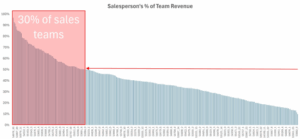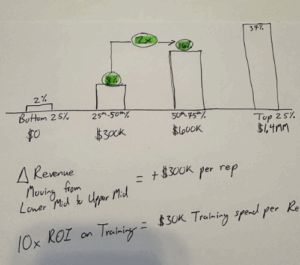
The ROI of Sales Training: What the Data Really Shows
Table of Contents
ToggleFor years, companies have debated the return on investment (ROI) of sales training. Budgets for learning and development continue to fluctuate, while sales compensation packages (OTE) keep rising. Yet one question remains central: How much impact can effective sales training really have on performance, and how much should companies be willing to invest?
Objective Management Group’s (OMG) research, combined with external studies and partner data, sheds light on this critical question.
The Performance Gap Between Top and Bottom Producers
Our analysis of 318 sales teams assessed in the past year uncovered a striking imbalance:
- 30% of teams relied on a single salesperson for more than half of their revenue.
- On average, top producers generate 10x more revenue than bottom producers.
This level of concentration risk makes many sales organizations vulnerable. When a team’s success depends on one or two individuals, growth stalls and succession risk skyrockets. It also highlights how much upside exists when organizations raise performance across the broader team.
The Evidence for ROI
Multiple data sources confirm the measurable value of training:
- Accenture found that overall corporate training delivers a 353% ROI.
- OMG Partner ValueSelling Associates reported that training accounted for 57% of the increase in their clients’ sales.
- OMG’s own research shows that training has the equivalent effect of moving a salesperson from under 70% of quota to more than 90%.
For a company, that shift can mean the difference between consistently missing targets and building predictable revenue growth.
What Happens When Salespeople Improve by Just One Tier
Perhaps the most overlooked ROI driver is what happens when companies elevate their “middle” performers.
When OMG analyzed revenue contribution:
- Salespeople in the lower middle quartile contributed about 8% of team revenue.
- Those in the upper middle quartile contributed 16%.
That means if a “Low Mediocre” rep producing $300K annually moves up just one tier to “High Mediocre,” they could generate $600K instead—a 2x increase.
With that math, a company aiming for a 10x ROI on training should be willing to spend up to $30K per salesperson to achieve that lift. Yet the average spend on sales training today is less than $2K per salesperson.
The gap between current investment and potential return is enormous.
What This Means for Sales Leaders
The data makes one thing clear: the ROI on sales training is not just positive. It’s astronomical when done well. The challenge isn’t proving the value, but in prioritizing the investment and structuring programs to move the performance needle.
Relying on a single top producer or tolerating large pockets of underperformance is a high-risk strategy. Shifting even a portion of the sales team upward creates measurable, compounding gains in revenue, stability, and growth potential.
Final Thought
Sales training isn’t just an expense. It’s one of the most overlooked levers of revenue growth. Companies that approach training strategically, backed by data and proper evaluation, can reduce risk, strengthen performance across the team, and achieve returns far beyond their initial spend.



